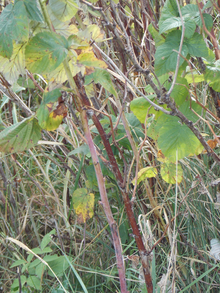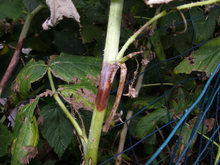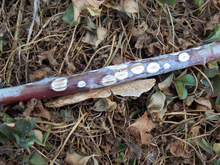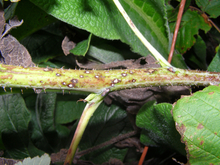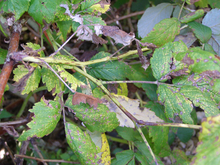Quick facts
- Spur blight, anthracnose and cane blight are fungal diseases that infect raspberries.
- Cane diseases can kill part or all of the raspberry cane. This reduces yield the following year.
- Cane disease fungi thrive in wet weather and spread on splashing water.
- Reduce cane diseases by maintaining narrow beds and open canopies within the raspberry patch.
- Remove all floricanes and infected primocanes after harvest.
See Growing raspberries in the home garden for more information on keeping plants healthy.
How to identify cane diseases
- Cane diseases can infect red raspberry, black raspberry and blackberry.
- Some cane disease fungi survive on wild Rubus spp. and other woody plants.
- Anthracnose is most severe in black raspberries. It can cause some damage to red raspberries as well.
- Cane blight and spur blight can cause significant damage to red raspberry.
The best time to identify all three cane diseases is to look at primocanes in late summer and early fall.
- Primocanes are first year canes that sprout in the spring.
- The green fleshy stalks of primocanes are easily infected by the fungi that cause cane diseases.
- The unique symptoms of each disease can be seen on primocanes in late summer and early fall before the canes turns brown.
In the spring, the overwintering canes are often dead from the disease. These diseased, dead canes are often mistaken for winter injury. Disease symptoms are not easy to see in brown bark and dead canes.
- When winter injury is the only cause of cane death, the canes die back to snow level and the floricanes will sprout in living buds below the snow level.
- In raspberry patches infected with cane diseases, the floricanes die to the ground or to the infected part of the cane.
Symptoms
Each disease has specific symptoms and each infects a different part of the cane.
- Spur blight infects the leaves and the node (the part of the cane where the leaves grow).
- Cane blight infections start anywhere the cane is wounded.
- Anthracnose infects the parts of the cane between the leaves (internodes).
Spur blight is both a leaf disease and a cane disease.
Leaf symptoms
- Infections start out in the leaves.
- Leaf edges turn yellow and die.
- Lower leaves are most likely to be infected. The damage can be mistaken for normal leaf aging.
- When leaves are killed by spur blight, the petioles (leaf stem) remains on the cane even after the leaf falls off, whereas when leaves die from normal aging, the entire leaf falls off.
- The spur blight fungus moves from infected leaves into the cane.
Cane symptoms
- In the canes, spur blight starts out as a chocolate brown or purple spot.
- The location of the spot is just below the point where a leaf was attached to the primocane.
- The spots start out about 1/2 inch across, but quickly grow, sometimes encircling the entire cane.
- These spots are easily seen in primocanes, but may not be noticeable the following year when the canes develop brown bark.
- On overwintered canes, buds next to the infected nodes usually don’t sprout. This makes the plants look "leggy" since large areas of the lower cane produce no leaves or flowers.
- On floricanes, the bark peels away from the cane.
- When looking at the peeled bark with a magnifying glass, little black dots are visible.
- The little black dots are the spore producing structures of the spur blight fungus. These spores will infect primocanes the next summer.
- Small primocanes that sprouted later in the summer are more likely to die than large primocanes.
- Canes inside the row are more likely to die than canes on the edge of the row.
Cane symptoms
- Cane blight infections start in wound sites on the primocanes.
- A wound site can be where canes rubbed against each other or against a trellis wire.
- The infection spreads through the cane causing cankers to form.
- Cankers start out as reddish-brown streaks under the bark.
- The cankers can span several inches up and down the cane and may surround the cane.
- If the infection surrounds the stem, the entire cane may wilt and die.
Leaf symptoms
- Leaves growing from the infected section of the stem may wilt and die.
Anthracnose is very common on black raspberries. Some red raspberry varieties are also likely to be infected by anthracnose.
Cane symptoms
- Little round, sunken pits form in the bark of the cane.
- Usually, the edges of the pits are slightly raised above the surrounding bark.
- The spots are white to pale tan.
- Sometimes the edges of the spots are a purplish-red.
- Anthracnose spots are usually less than 1/4 inch across which is smaller than spur blight or cane blight spots.
- Unlike spur blight, the anthracnose spots are scattered throughout the cane between the nodes.
- In the winter, raspberry canes with anthracnose often die to snow level.
Leaf symptoms
- When disease pressure is high, the leaves will also have small, round, purple spots with a light colored center.
How do cane diseases survive and spread?
- Raspberry cane diseases are caused by three different fungi.
- Cane blight is caused by Leptosphaeria coniothyrium.
- Spur blight is caused by Didyimella applanata.
- Anthracnose is caused by Elsinoe venata.
- These fungi can be brought into a garden on raspberry plants that are infected with the disease or from nearby, wild plants.
- Fungi survive winter in infected floricanes.
- Fungal spores of all three diseases are produced on infected floricanes during wet weather.
- The fungi that cause anthracnose and cane blight only spread by splashing water. The fungus that causes spur blight spreads by the wind as well as splashing water.
- Infection occurs on different plant parts for each disease.
- The anthracnose fungus infects only young green tissue. It can infect primocanes, leaves, fruit, flower buds, and leaf stems.
- The cane blight fungus infects canes through wounds only. Wounded young canes quickly develop severe disease. By fall, canes of red raspberry are resistant to infection.
- The spur blight fungus infects mature leaves on the lower third of the plant. The fungus grows through the leaf stem into the cane. Young leaves are resistant.
- None of the cane diseases infect the roots.
- Fungal spores are produced on infected plant parts throughout the growing season whenever wet weather occurs.
- Splashing water moves spores throughout the plant and to neighboring plants.
How to manage cane diseases
Provide good air circulation
- All three cane diseases thrive in moist conditions.
- Improving airflow through the patch will allow plants to dry quickly after rain or dew.
- Use drip irrigation when possible. If using a sprinkler is the only option, water early on a sunny day so that leaves dry quickly in the sun.
- Keeping the rows narrow will help the plants dry quickly. A recommended row width is 18 inches.
- Mow canes that have spread into the walking aisle to maintain a narrow planting row.
- Remove all weeds from the raspberry patch to improve air circulation around the canes.
Remove floricanes after harvest
- Always remove floricanes after they have produced a crop.
- Typically, old floricanes start dying towards the end of harvest, but some will remain green until early fall.
- For disease control, the best time to remove dead canes is during the weeks following harvest in late July or early August, even if some of the leaves are still green.
Prune out diseased primocanes
- After harvest, remove any primocanes showing clear disease symptoms.
- Cutting dead and infected canes removes the fungal pathogen from the patch. It also increases air flow through the raspberry patch.
- Remove diseased canes from the patch. If left nearby, they will be a source of spores for new infections.
- Diseased plant material can be burned, buried or composted.
Mow the patch in late winter
A more drastic way to control cane diseases is to mow the whole raspberry patch in late winter or early spring and remove or burn the canes. Mowing will reduce cane diseases and protect the crop for the following summer.
- All cane diseases move from the overwintered floricanes to the newly-sprouted primocanes.
- Cutting and removing all floricanes will sharply reduce new infections.
For fall-bearing raspberries:
- Fall-bearing raspberries will produce fruit on primocanes.
- If you mow the patch, you’ll still have a raspberry crop the next year.
- Mowing is often used for fall-bearing raspberries to reduce labor.
For summer-bearing raspberries:
- Summer-bearing raspberries are produced on floricanes.
- If you mow all the canes, you won’t have a crop the next summer.
- You can mow summer-bearing raspberries if cane diseases have been a big problem.
If all the canes died to the ground during the winter:
- In some years, cane diseases kill nearly all of the canes in certain raspberry patches, resulting in little or no crop the following summer.
- Inspect the patch after the leaves sprout in the spring. If most of the canes died to the ground during the winter, remove all the canes to prevent disease from spreading to the new canes that will grow in summer.
Fungicides
Fungicides are rarely necessary, but they can be used to reduce cane diseases in severely infected patches.
- The best time to spray for cane diseases is in early summer, before wet weather allows the primocanes to become infected.
- Direct sprays to cover all primocanes.
- These fungicides provide some protection from cane diseases in raspberries.
- Copper sulfate (some formulations are organic)
- Myclobutanil
- Actinovate (organic)
- Oxidate (organic)
- Fungicides will only partially control the diseases.
- Fungicides are more effective if the canes have been mowed in late winter.
CAUTION: Mention of a pesticide or use of a pesticide label is for educational purposes only. Always follow the pesticide label directions attached to the pesticide container you are using. Be sure that the plant you wish to treat is listed on the label of the pesticide you intend to use. And observe the number of days between pesticide application and when you can harvest your crop. Remember, the label is the law.
Reviewed in 2024


